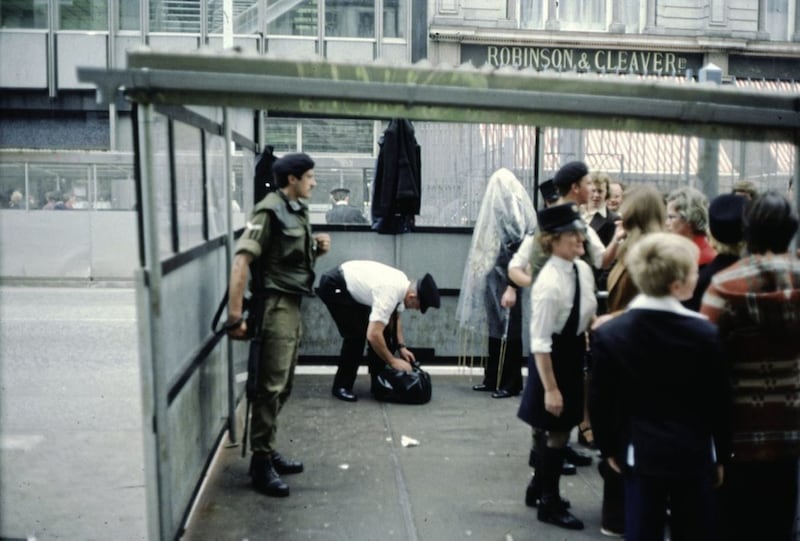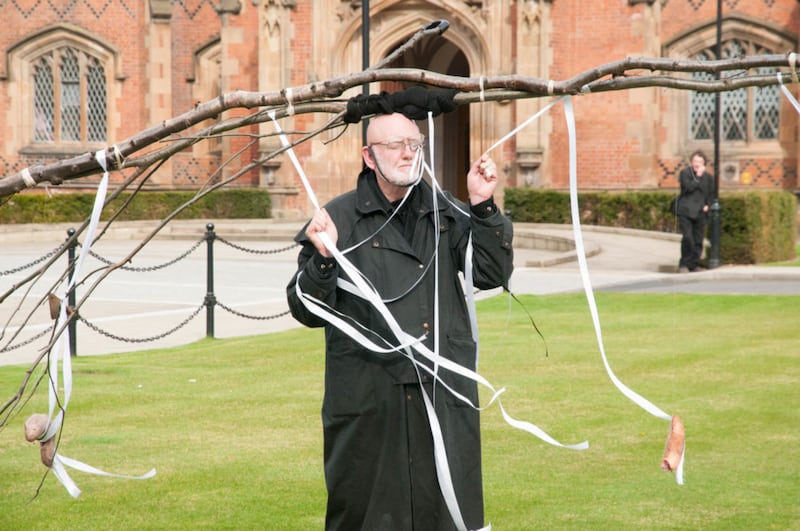"IT WAS a very oppressive feeling as you were going up Royal Avenue," recalls Alastair MacLennan of the atmosphere created by Belfast city centre's infamous 'ring of steel' security cordon in the 1970s.
In 1977, Perthshire-born MacLennan was living in east Belfast and regularly commuting to and from the Ulster Polytechnic at York Street – which meant passing through the manned checkpoints at Donegall Place and Royal Avenue at least twice a day.
"I would get a bus which would stop at the side of the City Hall and then you had to go up [to Donegall Place] and get searched," remembers Greenisland-based MacLennan (79) of his morning routine while teaching first year Fine Art in Belfast, a job he took in 1975 having already made a name for himself as a respected new performance artist with live 'actuations' staged in the US and Canada.
"The Army was based in Royal Avenue too, with these big barbed wire barriers and so on. It gave you a really really constricted feeling, and I was aware that other people would be feeling that oppressiveness too, whatever background they were from.
"I remember sometimes you'd be woken at 2 or 3 in the morning by the sound of a bomb blast and helicopters flying low – then you'd walk up Royal Avenue and see a small shop that had just been blown apart and wonder, 'Was that the blast I heard?'."
Having taken the art college job partly on the strength of "synchronicity" – "the advert mentioned 'Jordanstown', which was similar to 'Jordanstone', the name of the college I went to when I was 17," he tells me – MacLennan set about introducing his students to the notion of live performance as a legitimate form of artistic expression.
"I was doing experimental things with the students that would involve them as groups, from both sides of the community," he explains.
"I was trying to be inclusive, and the students were great. I'd seen the Orange marches during the summer, so when one of the first year students said he'd been asked by Queen's if we wanted to participate in their festival, we staged our own march from the art school right the way up to Queen's, where we wore these all-white gowns with the word 'Art' on the back."
Sadly, it seems that this cross-community approach to art did not sit well with some of the loyalist locals in his adopted east Belfast neighbourhood.
"When I first arrived in Belfast, I was staying in Moorgate Street just off the Newtownards Road," explains MacLennan, who studied art at Duncan of Jordanstone College of Art and Design and received his Masters in Fine Art from the School of the Art Institute of Chicago.
"I realised it was quite a 'heavy' area and I began to get threats.
"There was no performance art being made in Belfast at the time, where you use your own body as a 'material'. I'd started to do a weekly performance just to show the students other ways of doing things as well as the normal painting and sculpture and stuff.
"I did a performance where I covered my coat with all this garbage that was just lying around outside. Somebody from the Belfast Telegraph photographed it and, surprise surprise, next thing this guy comes to my door to tell me, 'We know who you are – we know what you're doing'."
Sectarian graffiti was also daubed on MacLennan's back door and the experience sowed the seeds for another far more provocative actuation.
Target found the Scotsman presenting himself as a literal 'target' during his daily commute to the art college through the 'ring of steel': a dartboard was slung around his neck to become a handy visual metaphor, while plastic sheeting marked-up with arrows was worn over the top of his clothing to provide a degree of anonymity while simultaneously offering comment on the horrific violence of the Troubles.


"I'd begun to feel a kind of 'victim' myself you know?", recalls MacLennan of what motivated his daily performances throughout August 1977.
"I was trying to think more holistically, so I thought, 'Let's see if I can turn this negative into a positive'. I decided to try and make it into an artwork where I would become a 'target' coming up Royal Avenue.
"I was very concious that I could be shot, because of the Army snipers and so on, so it was kind of scary doing it. But I thought, 'I have to do this thing and not be intimidated by threats'.
"I spent the night before writing out a wee statement in case I got shot, so it would be found if anything happened. I wore the plastic sheeting in case I got shot – I didn't want to make a mess in the street with all the blood and stuff, and it also kind of represented a body bag.
"I was interested in those kind of plural associations. I wanted this thing to actually function as a sign or a symbol, as a visual metaphor for what people were feeling."
After taking the bus into the city centre, MacLennan would then don his Target outfit prior to approaching the security checkpoint at the top of Donegall Place.
"There was a kind of apprehension on their part," he says of the reaction he received from the Army and civilian search staff.
"But I just spread my arms and so-on like you had to do. I had a wee black bag that I used to take to work with me and I remember this one Army guy sniffing all over it in case I had some sort of chemicals for a bomb or something in it."

Having passed through the cordon without incident, there was still the matter of negotiating the 10-minute walk to the art college amongst a mixture of RUC patrols, British Army soldiers and fellow civilians.
"Some people would try not to look, but you could see that they were like, 'What the heck is this?'" MacLennan says.
Happily, the artist did not draw fire from the security forces during his Target performances, which he admits were nerve-wracking – especially at first.
"I allowed myself five minutes before leaving the house that first morning to change my mind if I felt I couldn't do it," reveals MacLennan, who continued teaching at Ulster Polytechnic and University of Ulster for many years as well as helping to found Belfast's Art and Research Exchange and the international performance art charity Bbeyond.
"I remember standing just inside the front door and deciding, 'No, go on – you have to do this, otherwise how can you help your students to feel like they can make something creative out of any situation, positive, negative or a mixture of both?'"
Forty-five years on, Alastair MacLennan is still staging regular actuations and the artistic tradition he first introduced to his students and the Belfast public is still thriving. This week saw the annual Belfast International Festival of Performance Art (BIFPA) returning to the city, including an event titled Drawing The Ring of Steel in which performance artists recreated the Troubles-era security cordon with street markings and collected memories of the 'ring of steel' from passers by.
"BIFPA is organised by former students of mine," he tells me, with obvious pride.
"A lot of people still feel like art is just for the middle or upper classes, that it's not 'for them' – so doing performance art on the street makes it accessible to anyone and everyone.
"That's a big part of why I'm still doing it today."

:: Alastair MacLennan and Bbeyond will stage their monthly group performance at 12pm today at The Salmon of Knowledge ('the big fish') in Belfast as part of Belfast's International Festival of Performance Art. Visit the Alastair MacLennan Archive online at amaclennan-archive.ac.uk. Visit ringofsteel-belfast.com.




